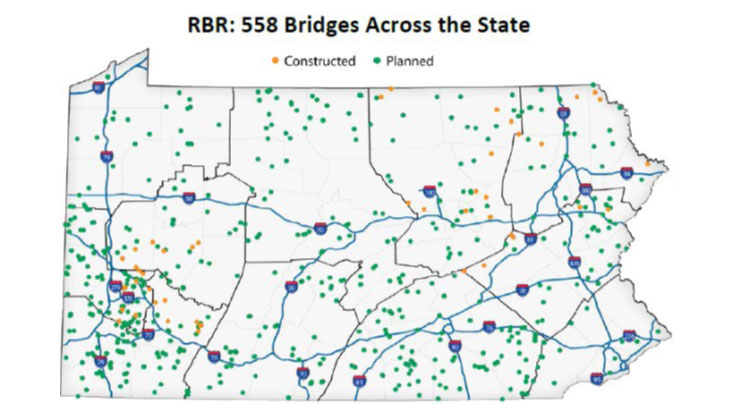
| Name of Agency | Pennsylvania Department of Transportation (PennDOT) |
|---|---|
| Location | Statewide |
| Project Delivery Method | Design-Build-Finance-Maintain (D-B-F-M) |
| Procurement Method | Best Value (90% price, 10% technical score) |
| Total Project Cost | Bid Price $899 million |
| Funding Source | Public-Private Partnership (P3), 100% State-Funded Payment Structure:
|
| Construction Schedule | 3 Years |
| Project Description | The Pennsylvania Rapid Bridge Replacement Project is replacing 558 structurally deficient bridges in 3 years under a single contract through an availability payment-based public-private partnership (P3). The bridges are primarily state-owned, smaller spans that are on roads with low traffic volumes in rural areas across the state. The project accelerated the replacement of the bridges with robust, high-quality new structures that will be well maintained and have longer lifespans. By bundling the replacement of over 500 bridges in a single P3 procurement and by applying asset management best practices throughout the 25-year concession period, PennDOT created efficiencies through economies of scale. The bridges have also been designed to minimize environmental impacts and public inconvenience during construction. |
| Project Website |
| Program Goals | To quickly reduce the number of poor bridges in the state bridge inventory. |
|---|---|
| Bridge Selection Criteria |
|
| Delivery and Procurement Method | Design-Build-Finance-Maintain (D-B-F-M), Best Value |
| Funding Sources, Financing Strategy | Public-Private Partnership. 100% State-Funded (followed federal regulations so that federal funds could be used if needed). |
| Environmental, Right-of-Way, and Utility Considerations |
Lesson Learned: Utility companies had limited resources to move utilities.
|
| Risks |
|
| Owner Management/Quality Assurance |
Lesson Learned: It may have been better to have construction inspection paid for directly by PennDOT. |
| Stakeholder Communication |
|